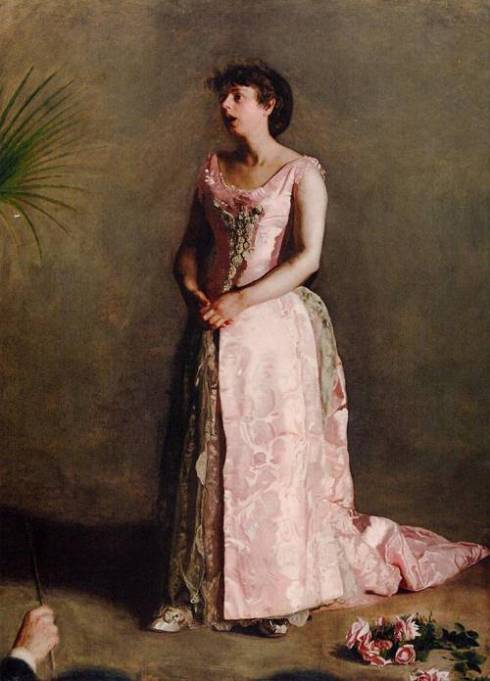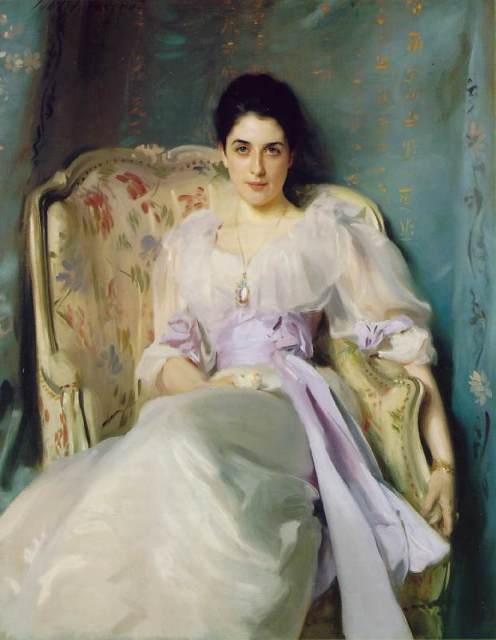Thomas Eakins, The Concert Singer, 1890-92
The following is a portrait painting titled “The Concert Singer” by American artist Thomas Eakins, dated 1890-92. We looked at a portrait painting by John Singer Sargent in our last couple posts and noted its realism. Eakins was another artist who had an affinity for painting truthful accounts of his models and who tried to capture their personality or life story through his drawings. If we observe the above painting, particularly her face, we can see that it is an unidealistic, honest portrait. For instance, the artist has chosen to include the lines under her eyes which underscore the wear and tear in her face, and he uses hard lines to paint the outline in her face created by the shadow on the side that’s facing away from the light in the room, both of which capture real, albeit slightly harsh, features.
Looking at singer Weda Cook, the figure in the portrait, we can see a woman moving her mouth and facial muscles as one does when singing a song. But even more, looking into her gaze, I get a sense of irritability from her. There is a look of boredom in her expression. This is probably because Eakins had Cook continually repeat the words “O rest in the Lord” (in the painting she’s making the “eh” sound in “rest”) in order to painstakingly capture the muscle movements in her throat. The professor during Tuesday’s class mentioned the tension between artist and model due to a reputation the artist had concerning a couple of sexual allegations with his prior models. What is more, Cook later explained how Eakins would persistently ask her to pose “down to my underclothes” (http://www.enotes.com/topic/The_Concert_Singer) and she would have to repeatedly and frustratingly decline. In the end, it ended up taking Eakins almost two years to complete the painting mostly because of the tension that existed between them.
Knowing this history between them, whenever I go to look at her face now, I sense a bit of an uncomfortableness in Cook’s gaze. Can anyone else see it too, particularly the first time you glanced at her face, or is it just my mind playing tricks on me?
This is the full response letter American artist John Singer Sargent wrote to some unhappy customer’s husband who had asked to repaint his wife in a softer, more appealing way (I discuss this letter and one of Sargent’s painting in my previous post). I don’t know which particular painting this is directed toward, but it’s believed that Sargent wrote many of these letters because of his affinity for realism, which was sometimes a little harsh.
Dear —–,
I have received your kind letter and if I thought an interview was of the slightest use and would not lead to a further discussion I would of course welcome it.
But the point on which we differ is one with which a long experience if portrait painting has made me perfectly familiar — I have very often been reproached with giving a hard expression to ladies portraits, especially when I have retained some look if intelligence in the face, besides amiability, as I consider myself forced to do in this case.
The expression of ‘s face in the portrait is kind and indulgent, with over and above this, a hint at a sense of humour. If I take this out, it will become as soft as anyone could desire. But as a matter of fact nothing will make me, much as I regret not meeting your wishes.
Yours truly,
John S. Sargent
(Charteris, P160)A link to the letter online: http://jssgallery.org/Paintings/Lady_Agnew.htm
John Singer Sargent, “Lady Agnew of Lochnaw”, 1892-93.
John Singer Sargent loved to paint strong, intelligent and beautiful women. Looking at the painting of Lady Agnew of Lochnaw, I can just see the artist fully charged and focused, excited and eager to paint away a portrait of the beautiful figure before him.
It is a well known fact that Sargent was a realist, painting what he saw and never what others wanted him to see. If fact, there’s a documented letter of Sargent responding to the husband of a dissatisfied patron who was asking Sargent to repaint his wife with more subtle, soft features, to which he kindly responded, “The expression of (unknown)’s face in the portrait is kind and indulgent, with over and above this, a hint at a sense of humour. If I take this out, it will become as soft as anyone could desire. But as a matter of fact nothing will make me, much as I regret not meeting your wishes.”
In the last post, we discussed Lady Agnew’s gaze. It is one of beauty and insight- of self-awareness and awareness of reality. The energy that exudes from her gaze is undeniable; we can’t help but be enthralled by it.
Let us now venture into the different elements of fashion to help us learn more about this portrait painting. In particular, we will pay attention to the style of costume, hair, and accessories.
Lady Agnew’s style of dress emphasizes her relaxed and confident appearance. The soft flow of the lilac silk sash that elegantly wraps her waist and defines her waistline, the soft piece of chiffon fabric that gracefully hangs around her neckline, the sheer sleeves and the overall movement and silkiness of the dress further add to the essence of chic and confident energy flow in the room.
Moving on to the accessories, we see that Lady Agnew is wearing only a necklace and bracelet. But this simplicity does not come as a surprise. She is wearing some jewelry to add a touch of elegance to the painting, but isn’t overdoing it with gaudy ornaments. The red and gold cameo necklace, a necklace which can often be seen being worn by Queens, is making a statement of wealth and sophistication, but is toned down by the simplicity in the bracelet on her right arm. Her wavy hair which has been parted to one side and picked up in a simple bun continues this look of simplicity and further underscores her effortless nature.
All in all, it’s a beautifully painted portrait and because of its attention to detail, it is very easy to read and get a feel for Lady Agnew’s character.
I will be dedicating this portion of my blog to analyzing the fashion and gaze in paintings from the turn of the twentieth century.
Let’s start with a painting shown in my art history class during the first couple days that really resonated with me.
This is a portrait of Lady Agnew of Lochnaw, painted by American artist John Singer Sargent, dated 1892-93. When I first saw this painting, I was instantly captivated by it, though I wasn’t really sure why. But once you let yourself get lost in her gaze and observe the poise in her posture, you begin to understand why it’s so alluring.
Gaze: Artists like to use the visual sense as a form of communication, and this painting does not disappoint. Looking into her eyes, one sees power and intellect. This look of intelligence mingled with a sense of self-assurance does not in the least bit appear insincere, but rather seems to portray her true inner beauty. Though there is a stark cleverness and attractiveness to her of which she is clearly aware, her physiognamy is not overwrought in these attributes to the point of appearing manipulative or sexually suggestive. This young female appears confident not cocky, beautiful not erotic, and assertive not dogmatic.
Moreover, though there is an intensity in her gaze, she is not staring at the viewer. The latter tends to have a negative connotation; after all, an individual who appears to be staring at you will probably make you feel uneasy and uncomfortable.
For example, the following is a random image of a modern day man that popped up after typing “man staring” on Google Images:
Contrast this with an individual directly gazing at you, which tends to be more sensual and less contrived.
For example, below is an image of another man that came up on Google Images after typing “man gazing”:
In case you were interested, typing “man staring” showed mostly scary or perverted facial expressions whereas “man gazing”showed mostly men softly looking into the camera.
All in all, both the stare and the gaze involve one looking at something/someone, but the latter evokes a more sensual feel that is comforting, not disrespectful or frightening.
Despite it being only one glimpse at Lady Agnew of Lochnaw, as the saying goes, this picture, in my opinion, is worth “a thousand words,” and it is being told mostly by her captivating eyes. I think the reason this picture caught my eye is because the person she genuinely appears to be, i.e., a strong, intelligent and beautiful woman who is comfortable in her own skin, is someone whose qualities I particularly admire.
Stay tuned for the next post, where Lady Agnew of Lochnaw’s fashion attire will be analyzed to further reveal the kind of person she was as well as to understand the goals of the artist in choosing the style of dress, hair and accessories for Lady Agnew.





